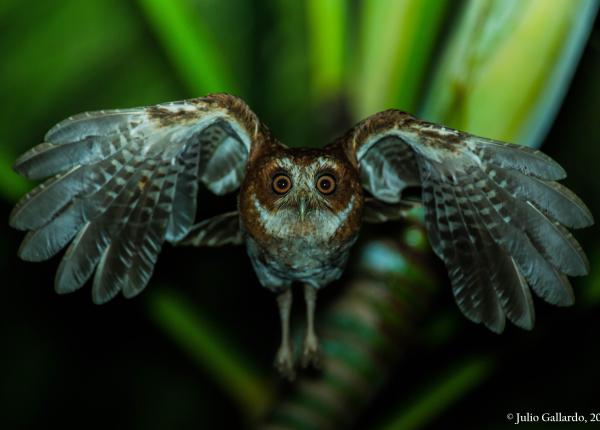Did You Know?
- The Puerto Rican Screech-owl is known locally in Spanish as “Múcaro,” a word that comes from the Taíno word “Múcuru.”
- The subspecies Megascops nudipes newtoni inhabited Puerto Rico’s offshore islands (Vieques and Culebra), the Virgin Islands (St. Thomas, St. John, and St. Croix), and the British Virgin Islands (Guana, Virgin Gorda, and Tortola). However, there have been no recent confirmed records of this subspecies since the 1900s. It is considered extremely rare or perhaps extinct.
How The Peregrine Fund is Helping
The Peregrine Fund is not working directly with Puerto Rican Screech-owls, but our conservation efforts through habitat protection, education, and community outreach extend to all raptor species, including this owl. Our West Indies project helps conserve birds of prey throughout the Caribbean. We also supply literature to researchers from our avian research library, which helps scientists the world over gather and share important information on raptor conservation. Lastly, we support the Neotropical Raptor Network, which helps conserve raptors by fostering collaboration and communication among raptor enthusiasts in the region.
Where it Lives
The Puerto Rican Screech-owl is the only arboreal owl and nocturnal raptor endemic to Puerto Rico. The species is common and widespread throughout the island. It can be found in forests, coasts, and urban areas throughout Puerto Rico. It prefers forests with a developed understory, hardwood trees for nest cavities, and dense vegetation to roost in during the day.
What it Does
This owl is small with a round head, bare legs (the Latin name for the species “nudipes” refers to its unfeathered legs), and a facial pattern of white “eyebrows” that form an “X” over the bill. Its plumage ranges from grayish brown to reddish-brown, it is white below and marked with brown streaks, and it has reddish-brown eyes. Females are slightly larger than males.
Although vocal throughout the year, this screech-owl can be hard to spot since it is nocturnal. It often calls while hidden deep within thick foliage during the evening and early in the morning. Its vocalizations have been described as a low-pitched trill and have also been compared to the sound of monkeys. Females and males often perform duets, singing together.
Why it Needs our Help
The population in Puerto Rico is believed to be stable, and this owl is considered a species of Least Concern. However, another bird found in Puerto Rico, the Pearly-eyed Thrasher, is known for eating the eggs of other birds, including those of the Puerto Rican Sharp-shinned Hawk. It is possible this thrasher could be causing some decline in the owl’s population by causing some nest failures.
Teaching people about the importance of owls is a good way to help protect them.
What it Eats
Puerto Rican Screech-owls feed mostly on insects and small vertebrates, such as anole lizards, coqui frogs, small birds, and rodents. Like other owls, they swallow their prey whole and then regurgitate the parts that can’t be digested in a hard pellet.
Nests, Eggs, and Young
Breeding season is believed to be from April to June. They generally nest in tree or other cavities and produce a clutch of one to three white eggs. Otherwise, very little is known about the nesting habits of this owl.
Puerto Rican Screech-owl and the World Center for Birds of Prey
The visitor center at The Peregrine Fund's World Center for Birds of Prey includes owls among its avian ambassadors. Though we don't have a Puerto Rican Screech-owl on site, a visit to the facilities is a great way to see other owls up close and to learn about the wonderful and interesting adaptations they have in order to survive in their respective habitats. There is also a touch table with owl feathers and other natural objects available for exploration.
References:
Curti, M. 2022. Raptors of the Caribbean: Education and Resource Guide. The Peregrine Fund
Goodson, C. (2021). Puerto Rican Owl (Gymnasio nudipes), version 1.1. In Birds of the World (T. S. Schulenberg, Editor). Cornell Lab of Ornithology, Ithaca, NY, USA. https://doi.org/10.2173/bow.prsowl.01.1
BirdLife International (2024) Species factsheet: Megascops nudipes. Downloaded from https://datazone.birdlife.org/species/factsheet/puerto-rican-screech-owl-megascops-nudipes on 15/04/2024.









